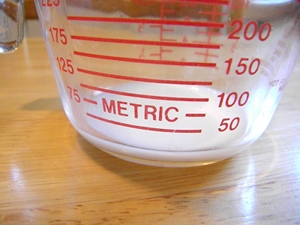 It takes plain simple logic — What goes in has to come out! The output on his diaper means you’re doing a good job. If your baby is getting 4-6 wet disposable diapers a day by the fourth day after birth OR 6-8 wet cloth diapers – your baby IS getting enough milk! If you are unsure what a wet diaper is like, put 2 tablespoons of water on it. It is best to judge the wetness of a disposable diaper by comparing its weight to a dry one than by the way the surface of the diaper feels to the touch. As your baby grows beyond the first month or so, the baby’s wet diapers will be even wetter – the equivalent of 4-6 tablespoons of water. Look out for signs of adequate hydration: pale or water-coloured urine suggests adequate hydration; darker, apple-juice-coloured urine (after the first four days) suggests that baby is not getting enough milk.
It takes plain simple logic — What goes in has to come out! The output on his diaper means you’re doing a good job. If your baby is getting 4-6 wet disposable diapers a day by the fourth day after birth OR 6-8 wet cloth diapers – your baby IS getting enough milk! If you are unsure what a wet diaper is like, put 2 tablespoons of water on it. It is best to judge the wetness of a disposable diaper by comparing its weight to a dry one than by the way the surface of the diaper feels to the touch. As your baby grows beyond the first month or so, the baby’s wet diapers will be even wetter – the equivalent of 4-6 tablespoons of water. Look out for signs of adequate hydration: pale or water-coloured urine suggests adequate hydration; darker, apple-juice-coloured urine (after the first four days) suggests that baby is not getting enough milk.
And of course, you must observe the stools too. During the early days, the baby’s stool gradually changes from the sticky black meconium stools to green, then brown and later becomes yellow like the colour of mustard. This is the normal colour of an exclusively breastfed baby. During the first few weeks, babies who are getting enough hindmilk (which is thicker and comes towards the end of a feed) will produce at least 2-3 yellow, seedy stools a day. Because breastmilk is a natural laxative, some breastfed babies tend to produce a stool (or stain) with each feeding. This is a good sign that baby is getting enough milk! After the sixth week, the frequency of bowel movements will normally decrease due to maturation of the gut. At this stage, your baby may normally have only one bowel movement a day; some breastfed babies have one bowel movement every three to four days. This is also a sign that they are getting enough milk.
Most infants, whether breastfed or bottle-fed, will lose an average of 5% – 7% of their birth weight in the first days of life, due to the loss of excess fluid. After regaining his birth weight, the average infant gains 113-142 grams (4-5 ounces) a week, or a minimum of 450 grams a month. Weight gain varies between babies but as long as it is within the normal range, do not worry!
Q: How can I improve the quality of my breastmilk? I’m worried my baby isn’t putting enough weight.
Breastfeeding is a confidence game, and nothing undermines a mother’s confidence like being afraid her baby isn’t getting enough milk. If your baby is producing enough wet diapers and bowel movements and he is gaining sufficient weight, he is getting enough milk! If you are concerned about the diet affecting the quality of you milk – you do not need a perfect diet to produce milk sufficient of nutrients and protective properties for your baby! Some believe that the number of calories you consume and the amount of fluid you drink has an effect on the quality and quantity of your milk, but there is no research-based evidence to prove this. Your breastmilk is unique to your baby and your body will provide all the nutrients your baby requires accordingly. I would suggest you to monitor these signs instead.
If we use plain simple logic – what comes in must come out! Good urine output means baby is getting a sufficient quantity of fluids from the milk. Good stool output tells you about the quality of the milk, (i.e. whether baby is nursing well and long enough to trigger mother’s milk ejection reflex, which brings the creamier, high-calorie hindmilk). When babies do not produce sufficient stools in the early weeks, it is important to assess the breastfeeding. Learn about efficient latching and suckling. Make sure to get help from a lactation consultant if you experience difficulties. Discuss with your doctor to determine if your baby needs supplementation during the time he is learning to breastfeed more efficiently. Please refer to our Breastfeeding Special article for more information.
by Rita Rahayu Omar (CISA, IBCLC)
Resident Consultant for Susuibu.com, Training, Consultancy & Educational Services
rita@thenurturing.com
27 June 2011
[download id=”2″ format=”3″]





